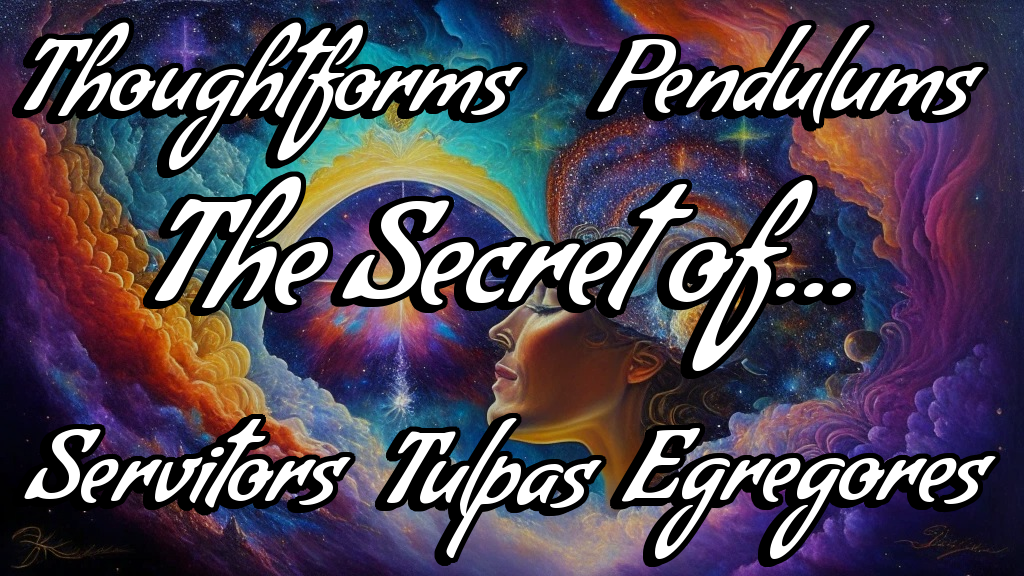In the world of metaphysical and esoteric traditions, the concepts of thoughtforms, servitors, tulpas, pendulums, and egregores hold profound significance. These intriguing phenomena delve into the realms of human consciousness, exploring the power of thought, intention, and collective belief. In this article, we embark on a journey to unravel the mysteries surrounding these concepts, aiming to understand their nature, creation, and influence.
These metaphysical entities are not mere abstract concepts but play active roles in shaping individuals’ experiences and collective realities. Thoughtforms, servitors, tulpas, pendulums, and egregores bridge the gap between the inner workings of the mind and the external world, reminding us of the intricate connection between consciousness and the tangible universe. As we delve deeper into each of these concepts, we aim to shed light on their unique qualities and unveil the potential they hold for personal growth, self-awareness, and the navigation of the intricate landscapes of human consciousness.
Understanding Thoughtforms
Thoughtforms are non-physical entities that originate from concentrated thoughts, emotions, or intentions. They possess distinct qualities, personalities, and energetic signatures, despite being intangible. These thoughtforms can be considered as manifestations of the energies we invest in them, taking shape in the unseen realms of our consciousness.
Thoughtforms manifest in various aspects of daily life. For instance, when individuals constantly worry about upcoming challenges, they generate a thoughtform of stress or anxiety. This thoughtform can impact their mental and emotional well-being, creating physical tension and emotional turmoil. Conversely, persistent feelings of love and gratitude can give rise to a thoughtform of positivity, which can enhance one’s overall life outlook and attract positive experiences.
The process of thoughtform creation commences with concentrated thoughts, emotions, or intentions. As individuals channel their mental and emotional energy into a particular idea or emotion, a thoughtform gradually takes shape. The more energy devoted to this focus, the more defined and potent the thoughtform becomes. These thoughtforms are essentially sculpted by our thoughts and emotions, existing on a spectrum from negative (for example stress) to positive (like love), mirroring our mental and emotional states.
Thoughtforms are not passive entities; they wield considerable influence over our lives. Negative thoughtforms can perpetuate cycles of stress, anxiety, and even physical ailments until managed effectively. In contrast, positive thoughtforms can uplift us, enhancing our resilience and well-being. Understanding thoughtforms empowers individuals to take charge of their mental and emotional energies, ultimately shaping their experiences and reality.
Servitors, Tulpas, Pendulums, and Egregores are all distinct types of thoughtforms, each with its own unique characteristics and roles. While all of these entities fall under the category of thoughtforms, they differ in terms of their origins, purposes, and levels of sentience and autonomy. Servitors and tulpas are individually created and personalized thoughtforms with specific functions. Pendulums are collective thoughtforms that influence individuals by drawing them into shared belief systems. Egregores, on a larger scale, represent the collective identity of cultural or social groups and exert a significant influence on the behavior and beliefs of their communities.
Let’s take a closer look at each individual type of thoughtform…
Servitors: Purposeful Thoughtforms with Independent Influence
Servitors are intentional thoughtforms with unique purposes and qualities. They stand apart from spontaneous thoughtforms, as they are deliberately created by individuals to serve specific functions or tasks. These thoughtforms are brought to life through focused mental and emotional energies, imbuing them with distinct personalities, attributes, and purposes.
Servitors find application in various contexts. For instance, consider a protective servitor created to safeguard an individual from negative energies or psychic intrusions. This thoughtform acts as a vigilant guardian, warding off harmful influences and providing a sense of security. In another example, a creativity-enhancing servitor may inspire and facilitate an artist’s creative endeavors, acting as a muse and fostering artistic expression.
Creating a servitor begins with a clear and defined intention. Creators concentrate their thoughts, emotions, and energies on shaping and empowering the servitor according to its designated purpose. This concentrated focus, often accompanied by rituals, visualizations, and repetitive commands, brings the servitor to life. The more meticulous and sustained the effort, the more potent the servitor becomes. Servitors may take on various forms and characteristics, customized to suit their intended roles, from guardian beings to creative companions.
Servitors possess a degree of autonomy once created. They are tasked with fulfilling their designated roles and act independently, often surprising their creators with thoughts and insights that extend beyond conscious awareness. This autonomy allows servitors to influence their creators’ thoughts, emotions, behaviors, and choices. They serve as active co-creators of the shared reality, enhancing personal growth, protection, and manifestation while embodying the intended purpose for which they were brought to life.
Tulpas: The Sentient Thoughtforms of Tibetan Buddhism
While Servitors can exhibit autonomy in carrying out their designated roles, Tulpas, on the other hand, possess unique personalities, emotions, and a higher degree of sentience and independence compared to servitors.
Tulpas are thoughtforms that have their cultural origins in Tibetan Buddhism, where they were initially conceptualized as mind-created beings through meditation and spiritual practices. Tulpas exist alongside their creators and interact with the world, often reflecting aspects of their creators’ own subconscious minds.
Tulpas are employed in a variety of situations. In the practice of lucid dreaming for example, individuals may create tulpas as vivid dream characters or entities. These tulpas, though products of imagination, exhibit autonomy within the dream world, engaging in interactions and experiences that extend beyond the dreamer’s conscious control. Tulpas also appear in meditative practices, where they serve as inner guides, mentors, or sources of inspiration.
Tulpa creation is a contemplative and meditative process. Creators embark on a journey of self-exploration and self-reflection, nurturing the tulpa’s development over time. Visualization exercises, accompanied by intense focus, are central to this process. Through mental images, creators shape the tulpa’s appearance, personality traits, and characteristics, fostering its growth and development.
Tulpas evolve as creators invest attention and interaction into their growth. Through meditation, visualization, and ongoing dialogue, tulpas gradually gain sentience and independence. They develop unique voices, emotions, and perspectives, eventually becoming co-creators of their shared reality, and participating in the ongoing dialogue of their creators’ inner worlds.
Pendulums: The Invisible Forces Behind Human Behavior
In the book “Reality Transurfing”, author Vadim Zeland introduces us to the concept of pendulums. According to Zeland, pendulums are depicted as powerful thought structures or energy fields that can strongly influence human behavior and choices. These pendulums represent collective belief systems, ideologies, or thought patterns that gain strength through the collective resonance and attention of individuals who subscribe to them.
Pendulums can manifest in various aspects of life. For example, political pendulums can sway public opinion and decisions, leading people to align with specific political ideologies or parties. Consumerism pendulums can drive excessive consumption and materialism, influencing individuals to pursue material wealth and possessions. Religious pendulums guide the beliefs and behaviors of religious communities, often shaping moral values and practices.
Pendulums form as a result of collective resonance, where groups of individuals share common beliefs, emotions, or thought patterns. When people invest their mental and emotional energy in a particular ideology or cause, they inadvertently contribute to the formation of a pendulum. This shared focus and energy create an energetic field that perpetuates the pendulum’s existence.
Pendulums exert a profound influence on human behavior and choices. They can pull individuals into their energetic fields, causing conformity to the pendulum’s principles, even when they may contradict an individual’s personal values or desires. This influence can lead to the adoption of certain belief systems or behaviors that align with the pendulum’s agenda.
Egregores: The Collective Thoughtforms that Shape Society
While both pendulums and egregores involve collective thoughtforms, the key differences lie in their origin, scope, and level of influence. Pendulums are often more specific and dynamic, drawing energy from individuals who engage with them, while egregores are broader and deeply ingrained in the collective consciousness of a group or culture. These entities represent the collective identity, beliefs, and consciousness of cultural, corporate, religious, and social groups. Their influence extends far beyond the individual, shaping societies and the lives of those within these groups.
Egregores can be found in various domains. Religious egregores, for instance, embody the shared faith and rituals of religious communities, influencing their beliefs and guiding their moral values. Corporate egregores represent the identity and culture of businesses and corporations, impacting the behaviors and decisions of both employees and clientele. Cultural egregores embody the values and traditions of nations or ethnic groups, shaping their identities and worldviews. Social egregores, like political or activist movements, influence the ideologies and actions of their adherents.
Egregores form and thrive through shared beliefs, rituals, and intentions. As individuals within a group collectively invest their mental and emotional energies into their shared beliefs and practices, they inadvertently contribute to the creation and sustenance of an egregore. These shared elements serve as the building blocks upon which the egregore is constructed, and they gain strength over time through continued focus and devotion.
Egregores possess the ability to shape the course of history, influence political landscapes, and guide cultural movements. They shape societies by instilling shared values and norms, often transcending individual differences. Egregores can hold considerable sway over individuals’ behavior, as they become entangled in the energetic field of the egregore, making choices and decisions that align with its principles, even if they contradict personal beliefs or desires.
The Hidden Entities Within: Reflections on Thoughtforms
In this article, we’ve delved into the intricate world of thoughtforms, servitors, tulpas, pendulums, and egregores, each a unique facet of metaphysical and esoteric traditions. Thoughtforms are the ethereal products of our concentrated thoughts and emotions, shaping our daily experiences. Servitors, with distinct purposes, act as purposeful extensions of our will, while tulpas are sentient companions born from meditation and visualization practices.
Pendulums represent powerful thought structures that influence human behavior through collective resonance and attention. Lastly, egregores embody the collective identities and beliefs of cultural, corporate, religious, and social groups, leaving an indelible mark on societies and individuals alike.
Understanding these concepts is paramount for personal growth and self-awareness. By grasping the influence of thoughtforms and their various forms, we can take charge of our mental and emotional energies, shaping our experiences and reality. Moreover, these concepts beckon us to explore the realms of metaphysics and collective consciousness, offering a deeper understanding of the interconnectedness of human thought and experience.
As we conclude, it’s crucial to reflect on the profound impact of thoughtforms on our understanding of consciousness and reality. These entities serve as bridges between our inner worlds and the external universe, prompting us to acknowledge the intricate web of human connectivity. Embracing this knowledge empowers us to navigate our inner landscapes with greater mindfulness, ultimately fostering personal growth and enhancing our comprehension of the collective consciousness that shapes our shared reality.
To learn more about thoughtforms, we recommend the following books:
“Thought-Forms” by Annie Besant and C.W. Leadbeater
“Magickal Servitors” by Damon Brand
“Tulpa: Thought-Forms” by C.W. Leadbeater
“Reality Transurfing” by Vedim Zeland
As an Amazon Associate, I earn from qualifying purchases. Thanks for your support!





